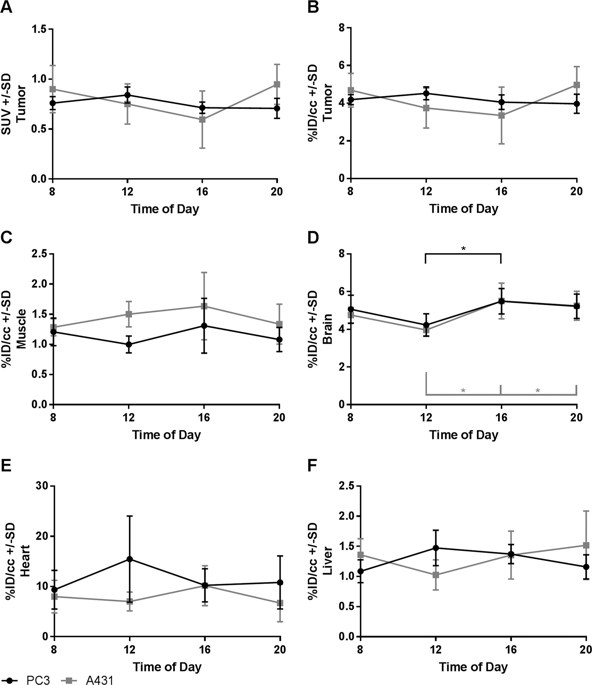Scientific Reports ( IF 3.8 ) Pub Date : 2020-03-27 , DOI: 10.1038/s41598-020-62532-8 Marcel A Krueger 1 , Carsten Calaminus 1 , Julia Schmitt 1 , Bernd J Pichler 1

|
The inner clock of biological organisms plays a pivotal role and has strong effects on metabolic processes such as glucose consumption. Since the commonly used positron emission tomography (PET) tracer 18F-flourodeoxygucose (FDG) is a glucose analogue, it is not surprising that the FDG distribution in mice and humans has been shown to succumb to daily rhythms. In preclinical studies, the circadian rhythm of animals is often not considered, and studies are performed at different times of day. Only a few studies have analyzed the effect of the circadian rhythm on FDG uptake in mice, and none of these studies included human tumor xenografts. Therefore, it is not known how strongly a preclinical tumor study is influenced by the time of day. In this work, the effect of the circadian rhythm on FDG uptake in human tumor xenografts and other organs was analyzed. CD1 nu/nu mice were kept for three weeks under a 12 h light/12 h dark rhythm and then injected s.c. with PC3 or A431 tumor cells. When the tumors had reached an appropriate volume, FDG-PET scans were performed on different animal groups (n = 4–5) every 4 h over a time period from 8 A.M. to 8 P.M. Tracer uptake in the tumors and in other organs was determined based on the PET scans and biodistribution studies. The standardized uptake value and %injected dose/cc of the tumors remained constant over the whole observed time period, and no statistically significant differences were determined according to the PET analysis. In the brain, we found a small but statistically significant increase from noon to 4 P.M., which led to a decrease in the tumor-to-brain ratio. No evidence for an effect of the circadian rhythm on FDG uptake could be found in subcutaneous tumors, however, in brain studies the circadian rhythm needs to be considered.
中文翻译:

昼夜节律影响脑部临床前FDG-PET定量,但不影响异种移植肿瘤。
生物的内部时钟起着举足轻重的作用,并且对代谢过程(如葡萄糖的消耗)具有强烈的影响。由于常用的正电子发射断层扫描(PET)示踪剂18F-氟去氧果糖(FDG)是一种葡萄糖类似物,毫不奇怪,已证明FDG在小鼠和人类中的分布会屈服于日常节律。在临床前研究中,通常不考虑动物的昼夜节律,并且研究是在一天的不同时间进行的。仅有少数研究分析了昼夜节律对小鼠FDG摄取的影响,这些研究均未包括人肿瘤异种移植物。因此,尚不清楚一天中的时间对临床前肿瘤研究的影响程度。在这项工作中,分析了昼夜节律对人类肿瘤异种移植物和其他器官中FDG摄取的影响。将CD1 nu / nu小鼠在12 h光照/ 12 h黑暗节奏下保持三周,然后向sc注射PC3或A431肿瘤细胞。当肿瘤达到适当的体积时,在8 AM至8 PM的时间段内,每4小时对不同动物组(n = 4-5)进行FDG-PET扫描。根据PET扫描和生物分布研究确定了肿瘤和其他器官中的示踪剂摄取。在整个观察到的时间段内,肿瘤的标准化摄取值和%注射剂量/ cc保持恒定,并且根据PET分析未确定统计学上的显着差异。在大脑中,我们发现从中午到下午4点有少量但统计学上显着的增加,这导致肿瘤与大脑的比率下降。在皮下肿瘤中没有发现昼夜节律对FDG摄取有影响的证据,但是,在大脑研究中,需要考虑昼夜节律。到8 PM,根据PET扫描和生物分布研究确定在肿瘤和其他器官中的示踪剂摄取。在整个观察到的时间段内,肿瘤的标准化摄取值和%注射剂量/ cc保持恒定,并且根据PET分析未确定统计学上的显着差异。在大脑中,我们发现从中午到下午4点有少量但统计学上显着的增加,这导致肿瘤与大脑的比率下降。在皮下肿瘤中没有发现昼夜节律对FDG摄取有影响的证据,但是,在大脑研究中,需要考虑昼夜节律。到8 PM,根据PET扫描和生物分布研究确定在肿瘤和其他器官中的示踪剂摄取。在整个观察到的时间段内,肿瘤的标准化摄取值和%注射剂量/ cc保持恒定,并且根据PET分析未确定统计学上的显着差异。在大脑中,我们发现从中午到下午4点有少量但统计学上显着的增加,这导致肿瘤与大脑的比率下降。在皮下肿瘤中没有发现昼夜节律对FDG摄取有影响的证据,但是,在大脑研究中,需要考虑昼夜节律。在整个观察到的时间段内,肿瘤的标准化摄取值和%注射剂量/ cc保持恒定,并且根据PET分析未确定统计学上的显着差异。在大脑中,我们发现从中午到下午4点有少量但统计学上显着的增加,这导致肿瘤与大脑的比率下降。在皮下肿瘤中没有发现昼夜节律对FDG摄取有影响的证据,但是,在大脑研究中,需要考虑昼夜节律。在整个观察到的时间段内,肿瘤的标准化摄取值和%注射剂量/ cc保持恒定,并且根据PET分析未确定统计学上的显着差异。在大脑中,我们发现从中午到下午4点有少量但统计学上显着的增加,这导致肿瘤与大脑的比率下降。在皮下肿瘤中没有发现昼夜节律对FDG摄取有影响的证据,但是,在大脑研究中,需要考虑昼夜节律。











































 京公网安备 11010802027423号
京公网安备 11010802027423号